
For each IUPAC name, draw the corresponding structural formula and line-angle formula.
- (a) Ethanol
- (b) Butanal
- (c) Butanoic acid
- (d) Ethanoic acid
- (e) Heptanoic acid
- (f) Propanoic acid
- (g) Octanal
- (h) Cyclopentene
- (i) Cyclopentanol
- (j) Cyclopentanone
- (k) Cyclohexanol
- (l) Propanone
(a)
Interpretation:
For the given IUPAC name, the corresponding structural formula and line–angle formula has to be drawn.
Concept Introduction:
Condensed structural formula:
Structural formula in which grouping of atoms are done and in which the central atoms along with the other atoms are connected to them are treated as group is known as Condensed structural formula.
Line–angle formula:
Structural formula where a line represent carbon‑carbon bond and the carbon atom is considered to be present in each point and the end of lines is known as Line-angle structural formula. This is a shorthand representation of an organic molecule with lines which represents its molecular bonding. In line–angle formula, hydrogen atoms are not shown.
Explanation of Solution
Given data:
Ethanol
Structural formula and line–angle formula:
From the name it is known that the compound has two carbon atoms. The name ends with suffix –ol which indicates that there will be an alcoholic
The structural formula and line–angle formula for ethanol is drawn below.

(b)
Interpretation:
For the given IUPAC name, the corresponding structural formula and line–angle formula has to be drawn.
Concept Introduction:
Condensed structural formula:
Structural formula in which grouping of atoms are done and in which the central atoms along with the other atoms are connected to them are treated as group is known as Condensed structural formula.
Line–angle formula:
Structural formula where a line represent carbon‑carbon bond and the carbon atom is considered to be present in each point and the end of lines is known as Line-angle structural formula. This is a shorthand representation of an organic molecule with lines which represents its molecular bonding. In line–angle formula, hydrogen atoms are not shown.
Explanation of Solution
Given data:
Butanal
Structural formula and line–angle formula:
From the name it is known that the compound has four carbon atoms. The name ends with suffix –al which indicates that there will be an aldehyde
The structural formula and line–angle formula for Butanal is drawn below.

(c)
Interpretation:
For the given IUPAC name, the corresponding structural formula and line–angle formula has to be drawn.
Concept Introduction:
Condensed structural formula:
Structural formula in which grouping of atoms are done and in which the central atoms along with the other atoms are connected to them are treated as group is known as Condensed structural formula.
Line–angle formula:
Structural formula where a line represent carbon‑carbon bond and the carbon atom is considered to be present in each point and the end of lines is known as Line-angle structural formula. This is a shorthand representation of an organic molecule with lines which represents its molecular bonding. In line–angle formula, hydrogen atoms are not shown.
Explanation of Solution
Given data:
Butanoic acid
Structural formula and line–angle formula:
From the name it is known that the compound has four carbon atoms. The name ends with suffix –oic acid which indicates that there will be an acid
The structural formula and line–angle formula for butanoic acid is drawn below.

(d)
Interpretation:
For the given IUPAC name, the corresponding structural formula and line–angle formula has to be drawn.
Concept Introduction:
Condensed structural formula:
Structural formula in which grouping of atoms are done and in which the central atoms along with the other atoms are connected to them are treated as group is known as Condensed structural formula.
Line–angle formula:
Structural formula where a line represent carbon‑carbon bond and the carbon atom is considered to be present in each point and the end of lines is known as Line-angle structural formula. This is a shorthand representation of an organic molecule with lines which represents its molecular bonding. In line–angle formula, hydrogen atoms are not shown.
Explanation of Solution
Given data:
Ethanoic acid
Structural formula and line–angle formula:
From the name it is known that the compound has two carbon atoms. The name ends with suffix –oic acid which indicates that there will be an acid
The structural formula and line–angle formula for ethanoic acid is drawn below.

(e)
Interpretation:
For the given IUPAC name, the corresponding structural formula and line–angle formula has to be drawn.
Concept Introduction:
Condensed structural formula:
Structural formula in which grouping of atoms are done and in which the central atoms along with the other atoms are connected to them are treated as group is known as Condensed structural formula.
Line–angle formula:
Structural formula where a line represent carbon‑carbon bond and the carbon atom is considered to be present in each point and the end of lines is known as Line-angle structural formula. This is a shorthand representation of an organic molecule with lines which represents its molecular bonding. In line–angle formula, hydrogen atoms are not shown.
Explanation of Solution
Given data:
Heptanoic acid
Structural formula and line–angle formula:
From the name it is known that the compound has seven carbon atoms. The name ends with suffix –oic acid which indicates that there will be an acid
The structural formula and line–angle formula for Heptanoic acid is drawn below.

(f)
Interpretation:
For the given IUPAC name, the corresponding structural formula and line–angle formula has to be drawn.
Concept Introduction:
Condensed structural formula:
Structural formula in which grouping of atoms are done and in which the central atoms along with the other atoms are connected to them are treated as group is known as Condensed structural formula.
Line–angle formula:
Structural formula where a line represent carbon‑carbon bond and the carbon atom is considered to be present in each point and the end of lines is known as Line-angle structural formula. This is a shorthand representation of an organic molecule with lines which represents its molecular bonding. In line–angle formula, hydrogen atoms are not shown.
Explanation of Solution
Given data:
Propanoic acid
Structural formula and line–angle formula:
From the name it is known that the longest chain has three carbon atoms. The name ends with suffix –oic acid which indicates that there will be an acid
The structural formula and line–angle formula for Propanoic acid is drawn below.

(g)
Interpretation:
For the given IUPAC name, the corresponding structural formula and line–angle formula has to be drawn.
Concept Introduction:
Condensed structural formula:
Structural formula in which grouping of atoms are done and in which the central atoms along with the other atoms are connected to them are treated as group is known as Condensed structural formula.
Line–angle formula:
Structural formula where a line represent carbon‑carbon bond and the carbon atom is considered to be present in each point and the end of lines is known as Line-angle structural formula. This is a shorthand representation of an organic molecule with lines which represents its molecular bonding. In line–angle formula, hydrogen atoms are not shown.
Explanation of Solution
Given data:
Octanal
Structural formula and line–angle formula:
From the name it is known that the longest chain has eight carbon atoms. The name ends with suffix –al which indicates that there will be an aldehyde group in the compound.
The structural formula and line–angle formula for Octanal is drawn below.
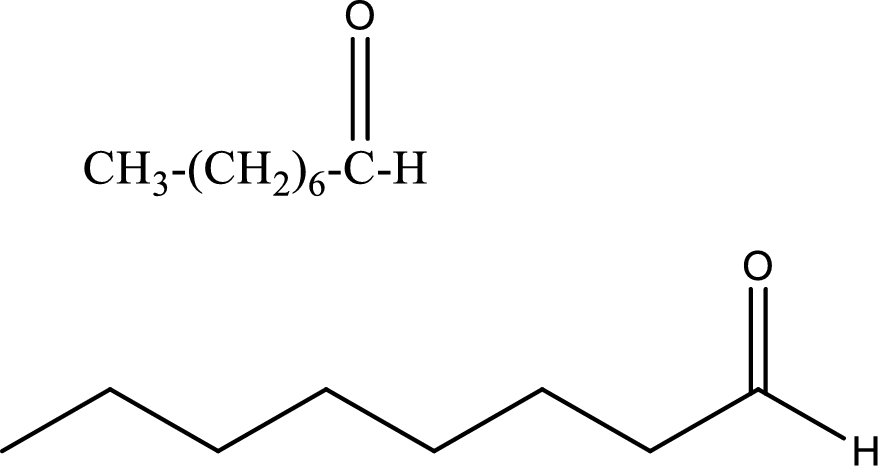
(h)
Interpretation:
For the given IUPAC name, the corresponding structural formula and line–angle formula has to be drawn.
Concept Introduction:
Condensed structural formula:
Structural formula in which grouping of atoms are done and in which the central atoms along with the other atoms are connected to them are treated as group is known as Condensed structural formula.
Line–angle formula:
Structural formula where a line represent carbon‑carbon bond and the carbon atom is considered to be present in each point and the end of lines is known as Line-angle structural formula. This is a shorthand representation of an organic molecule with lines which represents its molecular bonding. In line–angle formula, hydrogen atoms are not shown.
Explanation of Solution
Given data:
Cyclopentene
Structural formula and line–angle formula:
From the name it is known main core of the compound has a five membered cyclic ring. The name ends with suffix –ene which indicates that there will a double in the ring structure.
The structural formula and line–angle formula for Cyclopentene is drawn below.
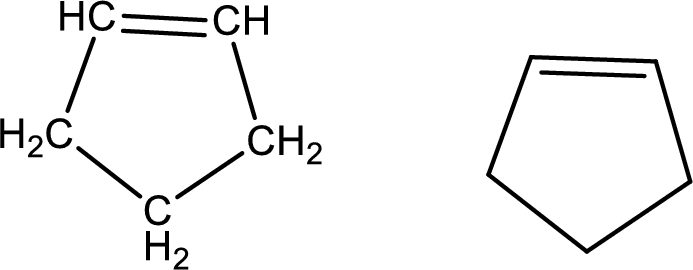
(i)
Interpretation:
For the given IUPAC name, the corresponding structural formula and line–angle formula has to be drawn.
Concept Introduction:
Condensed structural formula:
Structural formula in which grouping of atoms are done and in which the central atoms along with the other atoms are connected to them are treated as group is known as Condensed structural formula.
Line–angle formula:
Structural formula where a line represent carbon‑carbon bond and the carbon atom is considered to be present in each point and the end of lines is known as Line-angle structural formula. This is a shorthand representation of an organic molecule with lines which represents its molecular bonding. In line–angle formula, hydrogen atoms are not shown.
Explanation of Solution
Given data:
Cyclopentanol
Structural formula and line–angle formula:
From the name it is known that the main core of the compound has a five membered cyclic ring. The name ends with suffix –ol which indicates that there will be an alcoholic
The structural formula and line–angle formula for Cyclopentanol is drawn below.
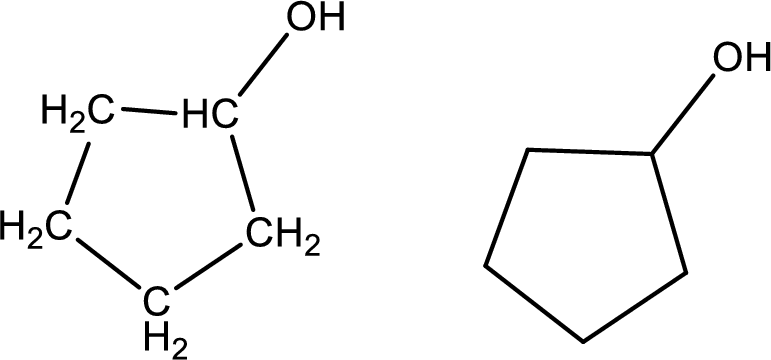
(j)
Interpretation:
For the given IUPAC name, the corresponding structural formula and line–angle formula has to be drawn.
Concept Introduction:
Condensed structural formula:
Structural formula in which grouping of atoms are done and in which the central atoms along with the other atoms are connected to them are treated as group is known as Condensed structural formula.
Line–angle formula:
Structural formula where a line represent carbon‑carbon bond and the carbon atom is considered to be present in each point and the end of lines is known as Line-angle structural formula. This is a shorthand representation of an organic molecule with lines which represents its molecular bonding. In line–angle formula, hydrogen atoms are not shown.
Explanation of Solution
Given data:
Cyclopentanone
Structural formula and line–angle formula:
From the name it is known that the main core of the compound has five membered cyclic ring structure. The name ends with suffix –one which indicates that there will be a ketone
The structural formula and line–angle formula for Cyclopentanone is drawn below.
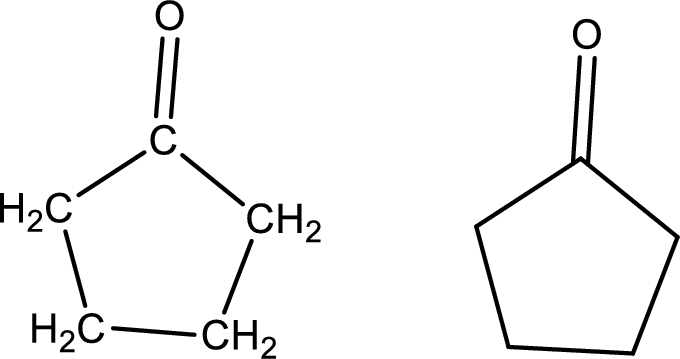
(k)
Interpretation:
For the given IUPAC name, the corresponding structural formula and line–angle formula has to be drawn.
Concept Introduction:
Condensed structural formula:
Structural formula in which grouping of atoms are done and in which the central atoms along with the other atoms are connected to them are treated as group is known as Condensed structural formula.
Line–angle formula:
Structural formula where a line represent carbon‑carbon bond and the carbon atom is considered to be present in each point and the end of lines is known as Line-angle structural formula. This is a shorthand representation of an organic molecule with lines which represents its molecular bonding. In line–angle formula, hydrogen atoms are not shown.
Explanation of Solution
Given data:
Cyclohexanol
Structural formula and line–angle formula:
From the name it is known that the main core of the compound has six membered cyclic ring structure. The name ends with suffix –ol which indicates that there will be an alcoholic
The structural formula and line–angle formula for Cyclohexanol is drawn below.
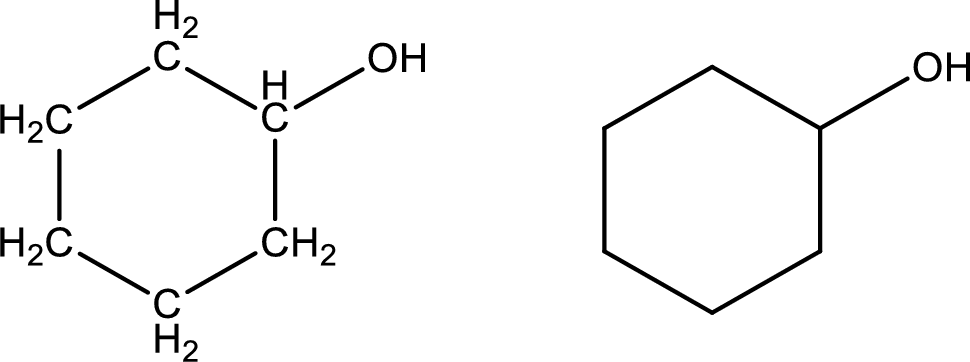
(l)
Interpretation:
For the given IUPAC name, the corresponding structural formula and line–angle formula has to be drawn.
Concept Introduction:
Condensed structural formula:
Structural formula in which grouping of atoms are done and in which the central atoms along with the other atoms are connected to them are treated as group is known as Condensed structural formula.
Line–angle formula:
Structural formula where a line represent carbon‑carbon bond and the carbon atom is considered to be present in each point and the end of lines is known as Line-angle structural formula. This is a shorthand representation of an organic molecule with lines which represents its molecular bonding. In line–angle formula, hydrogen atoms are not shown.
Explanation of Solution
Given data:
Propanone
Structural formula and line–angle formula:
From the name it is known that the longest chain has three carbon atoms. The name ends with suffix –one which indicates that there will be a ketone
The structural formula and line–angle formula for Propanone is drawn below.

Want to see more full solutions like this?
Chapter 2 Solutions
Organic Chemistry, Loose-leaf Version
- Briefly answer three from the followings: a. What are the four structures of the protein? b. Why is the side chain (R) attached to the alpha carbon in the amino acids is important for the function? c. What are the types of amino acids? And how is it depend on the (R) structure? d. Write a reaction to prepare an amino acid. prodarrow_forwardAnswe Answer A and B pleasearrow_forward3. Refer to the data below to answer the following questions: Isoelectric point Amino Acid Arginine 10.76 Glutamic Acid 3.22 Tryptophan 5.89 A. Define isoelectric point. B. The most basic amino acid is C. The most acidic amino acid is sidizo zoarrow_forward
- 3. A gas mixture contains 50 mol% H2 and 50 mol% He. 1.00-L samples of this gas mixture are mixed with variable volumes of O2 (at 0 °C and 1 atm). A spark is introduced to allow the mixture to undergo complete combustion. The final volume is measured at 0 °C and 1 atm. Which graph best depicts the final volume as a function of the volume of added O2? (A) 2.00 1.75 Final Volume, L 1.50 1.25 1.00 0.75 0.50 0.25 0.00 0.00 0.25 0.50 2.00 (B) 1.75 1.50 Final Volume, L 1.25 1.00 0.75 0.50- 0.25 0.00 0.75 1.00 0.00 0.25 Volume O₂ added, L 2 0.50 0.75 1.00 Volume O₂ added, L 2 2.00 2.00 (C) (D) 1.75 1.75 1.50 1.50 Final Volume, L 1.25 1.00 0.75 0.50 Final Volume, L 1.25 1.00 0.75 0.50 0.25 0.25 0.00 0.00 0.00 0.25 0.50 0.75 1.00 0.00 0.25 Volume O₂ added, L 0.50 0.75 1.00 Volume O₂ added, L 2arrow_forwardLeucine is an essential amino acid with the systematic name 2-amino-3-methylpentanoic acid. It has pai 2.36 and pKa2 = 9.60. H2N-C(R)H-COOH and R is -CH2-CH(CH3)2 A. Draw the condensed structure for leucine, and label all chirality centers with an asterisk. B. How many possible stereoisomers of leucine are there? C. Draw a Fischer projection of L-leucine and label the chirality center(s) as R or S. D. What is the p/ of leucine? E. Draw the structure of the predominant form of leucine at 10.00. F. Draw the structure of the predominant form of leucine at pH = 1.50. G. Leucine is described as an essential amino acid. What does this mean? H. Show the alkyl halide you would use to prepare leucine by the amidomalonate method. =arrow_forwarda) Write out 6 completely different reactions of acetophenone (reagent, product). b) Write out 3 preparations of 1-methylcyclohexanol, using a different starting material for each one. You may use preps where you just change the functional group, and/or preps where you construct the carbon chain. c) Write out 3 preparations of 2-ethoxybenzoic acid, a different starting material for each one. You may use preps where you just change the functional group, and/or preps where you construct the carbon chain.arrow_forward
- 12. CH3 OH OH H&C CH3 H₂C N OH H₂C CH3 H&C CH3 H₂C' CH3 H.C CH3OH H.C CH2CH3OH CH3CEN Which one of these 17 compounds is represented by this IR and this 'H NMR spectrum? IR Spectrum 3000 4000 3000 NMR Spectrum 2000 £500 RAVENUMBER 2000 1500 9 8 6 5 10 HP-00-290 ppm m 1000 500 1000 4 °arrow_forwardDraw the structure of (E,6R) 6-methoxy-4-hepten-2-one. Give the IUPAC name of this compound, including stereochemistry. Draw the most stable chair conformation of (cis) 1,3-isobutylcyclohexane. H HC=CCH₂ CH2CH3 EN(CH3)2 -CN(CH3)2arrow_forward10. Write out the mechanism (intermediate/transition state) for this reaction; indicate stereochemistry in product. H3C CH₂OH CH3 SN1 Harrow_forward
- Write "most" under the member of each trio which is most stable. Write "least under the member of each trio which is least stable. b) Draw a Fischer projection of a pair of enantiomers with three chiral carbons. Which of these two would you expect to be more soluble in water? Why? 1-butanol 1-heptanol Which of these two would you expect to have the higher boiling point? Why? hexyl methyl ether 1-heptanolarrow_forwardWrite "most" under the most acidic compound. Write "least" under the least acidic compound. OH NO₂ OCH3 Br 9. Compound X, C50H84F2, reacts with excess H2/Pd to give a C50H88F2 compound. How many rings are in X? How many double bonds are in X? Show your work.arrow_forward4. State whether these two are: a) the same molecule b) c) d) different compounds that are not isomers constitutional isomers diastereomers e) enantiomers CH3 CH₁₂ H OH HO H H OH HO H CH, CH₂ 5. a) How many stereocenters does this compound have? b) How many stereoisomers are possible for this compound? CH₂ OH CHCHarrow_forward
